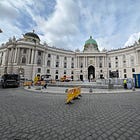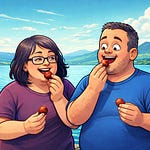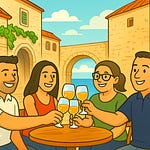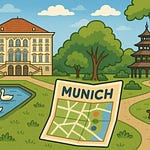Both: Hey everyone! It's Jen and Greg with an update on our travels.
Greg: This time we're talking about…Vienna!
Jen: Yay!
Greg: In the last update, we made a statement of - we felt despite Vienna being one of the most popular destinations in Europe, it is still underrated.
Jen: Yes, I agree. So to give you a little bit of context as to, to why we feel this way, Vienna has a lot of history. It goes back to 1273 when the Habsburg dynasty started their rule over a vast empire that included much of what we now call Central and Eastern Europe. This rule lasted until 1918.
Greg: Yeah, and Vienna was basically the de facto capital for the whole 650-year period, which makes it like the cultural heart and political heart of Central Europe.
Jen: Yeah, and this imperial legacy really helps explain their extraordinary architectural landscape. There are Gothic churches from the medieval period. There's lavish Baroque palaces and monuments from 17th and 18th centuries, like the Belvedere Palace and St. Charles Church. And then it goes into the 19th century where there's a combination of neo-Gothic and neo-Renaissance and neo-Baroque styles like the Opera House and Parliament, City Hall, all kind of make what Vienna is known for.
Greg: Yeah.
Jen: So the culture of Vienna during that period is just central to all of Europe and the world, really, because composers like Mozart and Beethoven thrive there. And Sigmund Freud developed psychoanalysis, which was a huge step in the field of psychology. And there were so many other artistic movements that flourished around the 1900s.
Greg: Yeah, look, the bottom line is, from our perspective, you hear people talk about the greatest capitals in Europe, and they mention Paris, they mention London, they mention Rome, and Vienna usually comes after. And our standpoint is Vienna absolutely should be mentioned in those names, if maybe not even the forefront of those names.
Jen: Agreed completely.
Greg: Yeah.
Jen: So when we arrived, that was actually day 137 of our travel. And like it has become our habit, we didn't eat breakfast that morning.
Greg: Right.
Jen: (laughs) Because breakfast is not really a thing in Europe, as we've said before.
Greg: Uh, and then, of course, we just checked in at our hotel, which was 600 feet from the State Opera House.
Jen: Yes. The hotel was called the Grand Hotel Wien. Like Greg said, it was very close to the Vienna State Opera House. And when we got there, we were given an upgrade. So we got a room with a terrace.
Greg: Yeah, it was a beautiful terrace.
Jen: Yes.
Greg: It was a nice hotel.
Jen: One of the cool things about the Grand Hotel Wien - it opened in 1870, and it was Vienna's first luxury hotel, and the first actually to be called “Grand” in the entire Austro-Hungarian Empire. And it featured so many different amenities that were revolutionary for their time. It had 300 rooms, steam-powered elevators, and it even had a telegraph office. It also had its host of celebrities that stayed there in the 19th and 20th centuries, and one of the most famous was Johann Strauss II, who became known as the “Waltz King”. He celebrated his 50-year jubilee at the hotel in 1894.
Greg: Yeah, so we left the hotel to get some food because by this point we had not eaten yet. And we really wanted to experience local food. It's kind of what, what we try to do everywhere we go. And Viennese food, I would describe as very similar to German food, except maybe a little more delicate, at least where we went.
Jen: We had a Wienerschnitzel and what they called a potato salad, but it was actually potatoes in butter with a little bit of balsamic vinegar over field greens. So it was a literal potato salad.
Greg: It was really good, though.
Jen: It was very good! But they didn't really have anything on the dessert menu that intrigued us. And dessert is one of our favorite things, let's be honest. So we pulled out the Google Maps and decided to search for dessert near us. And we found a place right down the road that was actually the original spot of one of our favorite desserts.
Greg: It is a Sacher Torte.
Jen: Yes, and this hotel has an entire gift shop that sells nothing but these tortes.
Greg: Yeah, and we bought…
Jen: Nothing but those tortes. (laughs)
Greg: (laughs) Yeah.
So the next day that we were there was our big walking around Vienna day. And that's really where I think we kind of developed our feelings because we started by walking towards what's called the Volksgarten, which, if you are familiar with German, means the “People's Garden”.
Jen: Greg's very fluent in German now, so he likes to translate things randomly.
Greg: I am not fluent, but it's interesting because you think of Volkswagen, it means “people's car”. In any case, while we were walking, we passed through several of the ‘platz’ and we passed buildings that it was like almost every 15 seconds we were, like, “What is that? What is this?”
Jen: Yeah, even the normal buildings, like regular offices and apartments, they were even pretty.
Greg: Yeah, they did a very good job of preserving a lot of that architecture from the 18th and the 19th centuries for which Vienna is known. And I, I love it for doing that.
Jen: Yeah, so some of the cool things that we saw along our walk were the Hofburg Palace, which is a huge building. I think now it's, like, a government building. And the Rathaus, off in the distance, you can see the spire of a building. And that's the city hall.
Um, but as we were walking along, looking at all these wonderful things, we smelled this horse smell.
Greg: Yeah, you know, like the stable kind of smell. It's very unique. And I saw some people standing in an area and then I just saw a horse and I just told Jennifer that was a horse.
Jen: And I thought he was crazy because nowhere along our walk did we see, like, horse-drawn carriages or anything like that. I didn't know what he was talking about.
Greg: Yes, so we just went over where other people were standing, and it was this glass area where you could look into what was kind of a big to-do stable as a part of the big, uh, palace building.
Jen: Yeah, and they were really pretty white horses. And I kind of walked around looking for a sign trying to explain what this was. And it was actually the Lipizzaner Stallions.
Now, if you grew up in the ‘80s, you may remember in your town seeing a commercial because these horses toured during that time. And I remember thinking, “Ahhh, that would be so cool to see because they were dancing horses!”
Greg: Yeah. And when we were watching the horses go from their arena back to the stable, we just said, let's see if they have tickets for any kind of performance while we're here.
Jen: Yeah. So they didn't have any tickets to a performance, but they do, um, sell tickets so you can watch their practice. So we decided to get some.
Greg: Yeah, they were pretty reasonably priced tickets too, so.
Jen: Yeah.
Greg: From there, we did walk through some other places like Josefplatz or Heldenplatz. But the big thing is we went to the National Library of Austria.
Jen: So, no surprise, I really enjoyed this library. It was amazing. You walk in and you feel like you're Belle from Beauty and the Beast walking into his library at the castle. There are floor-to-ceiling bookshelves filled with books, the rolling ladders, and just beautiful paintings on the ceilings, and everything was just ornate and lovely.
Greg: Yeah, a little bit of a disappointment because they had some kind of, like, tribute display as well. So if you see the pictures when we put ‘em up —
Jen: (scoffs)
Greg: — some of them may have like posters of this guy's face. Um, but overall, it was it was a really cool library.
From the library, we headed towards the State Opera House because we had a tour, but we had extra time and we saw that there was this tea shop, like, right across from the opera house. So we went in and not only did they sell, like, loose leaf tea and various things related, they also had a place in the back where they would serve you tea that they sold. It was really cool because we just described what we like and they created customized blends right there and brewed it. And we got two different teapots. And I think it was like 10 euro for both of us.
Jen: Yeah. And it was a very neat little environment, too. It was like you were in a back secret room having tea. We wound up buying some tea to travel with. So we have now become those people who bring their own tea places…
Greg: Which turned out to be good, because while we were traveling a few times, we were like, we would really like to enjoy some tea right now. And we have time. We have it.
Jen: Yep! (laughs)
Greg: So once we were done with that, we went across the street to the State Opera House. However, it was raining, so we kind of had to run. But thank goodness we had our little packable rain jackets.
Jen: Yes. Very smart purchase. Good job, Past Us! (laughs)
Greg: Yes!
Jen: But the Opera House is really cool to tour. Um, it still has four rooms that are original to when it was built in the mid-to-late 19th century. The rest has been restored from damage sustained in World War II and just due to age. Unfortunately, we weren't there during opera season. We were kind of hoping to be able to see one just to experience that. But we were a little too early.
Greg: Yes, the opera season is also extremely difficult to get tickets, uh, even for individual performances. And they have an annual gala at the beginning of the season, which is literally world famous. And people show up. I should say people with money show up —
Jen: Yeah.
Greg: — from all over the world to attend that ball.
Jen: Yeah, the videos that they had from it were…something to see.
Greg: Yeah. Something else that was really cool about the opera house is in the main auditorium, there's this massive chandelier.
Jen: Yeah. So this chandelier is made of, like, three tons of crystal with 1100 bulbs. And it even has its own maintenance walkways built inside it. The cleaning all has to be done from above because it can't be lowered. And it takes more than a week to do that.
Greg: Yeah. But it was a really magnificent chandelier.
Jen: It was. For sure.
Greg: So we left the State Opera House. We went, um, a little ways to St. Charles Church, which I know we talked about how we were starting to get a little burnt out on churches, but this one has some really nice architecture and, uh, was a highlight for people who do visit Vienna because they let you walk up to various levels where you can be literally right next to the organ, which was kind of neat. And there's a, an entryway up to the top of the church, which gives you a terrific view of big parts of the city.
Jen: So St. Charles Church was built because Emperor Charles VI made a vow during the plague of 1713 that if the city survived, he'd build a church dedicated to St. Charles Borromeo, who was famous for helping plague victims in Milan. There's two massive, like, 47-meter columns that flank each side of the entrance, and they were inspired by columns in Rome, and they show scenes from the saint's life.
Greg: Yeah, it was really impressive and I'm glad we decided to do it.
Jen: Yep. So that kind of rounded out day two in Vienna. And the next day was when we had tickets to see the Lipizzaner Stallion practice at the Spanish Riding School.
Greg: Yeah, which it was really neat, but it was also a little disappointing. We built it up in our own minds that it was going to be more of a rehearsal for things that they do during their performance. But instead, it was more of a workout for the horses.
Jen: The arena itself was really beautiful. And I think the highlight of it was the chandeliers that were over the arena floor. Welcome to Vienna.
Greg: Yeah, it definitely fit with a lot of the different styles that you would see around town.
Jen: I didn't see any signs saying no photography, so I was actually able to get quite a few good pictures until I got fussed at for taking those pictures. And because we want to be respectful, we'll just share some “official” photos from the website.
Greg: We didn't see any signage, but we want to comply. We want to be respectful of their rules. So…
Jen: Don't want any bootleg photos floating around out there.
Greg: Yeah.
Well, there was a very humorous event that happened while we were there. Jennifer was leaning over the railing at one point, looking down at, you know, the horses in the arena. And you could see while they were doing their exercises, periodically a rider would reach back and pat the horse on his haunches. And the horse would then turn his head around and they would give them a carrot or something. And while Jennifer's leaning over the railing, I just reached my hand over and patted her like they do the horses. And she turned her head like expecting a carrot. (laughs)
Jen: (laughs)
Greg: It was very funny. We laughed. But the guy and his wife who were next to us, he saw that and was amused. And he decided to pat his wife in the same way.
Jen: She was not amused.
Greg: She did not find it funny…at all.
Jen: (laughing) So naturally, we found that hilarious!
Greg: Yes, we laughed at his misfortune.
Jen: (still laughing)
Greg: Yeah, overall, while it was a little disappointing because it was just more of a workout, I'm still glad we went because it was a really neat experience.
Jen: Yeah, it was for sure.
Greg: So other than that practice, the big thing we did on this day was go to the Belvedere Palace, which used to be like a summer home for the royalty, but was converted into an art museum.
Jen: It amazes me when we go to these places that are called ‘summer homes’ for people.
Greg: Oh, yeah. No, I mean, the wealth disparity is clearly on display when they have things they call ‘cottages’ that in today's environment, we would say are full on mansions.
Jen: Yeah, but the palace architecture was definitely apparent in this building, but it's been redecorated to use as a museum.
Greg: We went to what's called Upper Belvedere, the main part of the art museum. And it is popular because of the collection of works by Gustav Klimt.
Jen: Yes. One of his most famous works is a painting called The Kiss. I hate to say this, but it kind of reminded me of like a five-year-old finger painting.
Greg: Yeah, I mean, I think the big thing is Gustav Klimt had work in the museum from his early period, which are fantastic and clearly demonstrates he had a great amount of skill.
Jen: He wouldn't be in a museum if he didn't.
Greg: Right. But there was a movement in art called the Vienna Secession, which was they rejected a lot of the old traditional ways of doing art and they intentionally painted things to look bad because it was contrasting so much with the previous style that everyone said things needed to be. At the time, it was considered avant-garde. But for me looking at it now, it just looks…bad.
Jen: (laughs) But I guess that's why they say art is subjective.
Greg: Yes. And there's a lot more than just how it looks, right? Like subject matter and how they portrayed women are all a part of that movement. But I mean, it was a little bit lost on me. However...
There was a portrait of a very famous chef at the time, also in the museum, a very smaller picture, done by Monet. And we were the only ones looking at it. And it was a terrific painting.
Jen: Yeah, when you stood far back from it, it almost looked like a photograph.
Greg: Yeah. And I don't want to oversell this, but keep in mind, I am not a fan of impressionists. And for me to say that this Monet portrait was terrific should tell you something.
Jen: It was cool. One of my favorite things and maybe one of my favorite exhibits that we saw in all of our museum tours across Europe was, um, a series of busts by Franz Messerschmidt, and it portrayed different emotions and expressions of people with different caricature, cartoonish, silly faces that I just really enjoyed.
Greg: Yeah, whoever he got to model for these busts did a very good job of really exaggerating his facial features, because I can't see how Messerschmitt could do that himself without a model.
Jen: Right.
Greg: There was also another section that was devoted to medieval art and early Renaissance art, which I appreciate. There was a beautiful triptych. If you're not familiar, it's this wooden, um, display used on altars where two smaller pieces on the side close over the centerpiece. Very reminiscent of your science fair, social studies fair project boards, right? And the outsides are usually stained wood, sometimes carved wood - and inside is usually a very ornately painted and decorated - sometimes gold leafing. And it's intended to represent whatever the patron saint is for the church or whatever religious event the church is dedicated to. And this one triptych in their museum was painted all the way around. Very, very well, too, for medieval style art. It was very, very well done. And you could walk all the way around and look at this thing. And I thought it was terrific.
Jen: Yeah, and there was also a piece that was from the 1100s, and it depicted Jesus on the cross. It was a wooden carving, which was actually the oldest piece in the museum.
Greg: Yeah, and we left out of the sort of art museum palace part, and behind it is this really cool garden, there’s a pond, and the sky and the weather were absolutely magnificent, so we got a couple of nice pictures.
Jen: Yeah, and because of the lovely weather, we decided to enjoy our terrace at the hotel, and we ordered room service and got to dine al fresco in Vienna.
Greg: Yeah, really enjoyed that way to kind of close out our time there. Also, the Sacher tortes that we purchased the day before were our dessert on the terrace as well.
Jen: (laughing) Yeah we, we ate those every day we were there.
Greg: Yeah. But, uh, the next day, we took a taxi because we were going to fly out of Vienna to go to Montenegro. There's not really, uh, train travel that you can do directly between those two locations, so flying was the only option.
Jen: Yeah, and we actually spent a month in Montenegro, and it was really fun to stay there. If you're like me, you had no idea where Montenegro is. I still don't know if I could find it on a map…
Greg: Well, if you look, it is right across the Adriatic Sea from Italy.
Jen: So we really enjoyed our time there. We got to enjoy the beaches there, the local town. We met some really great people. And we were even able to pop over to Old Dubrovnik in Croatia and spend the day with some really good friends of mine.
Greg: Yeah, so we look forward to telling you about our time in Montenegro and the beaches and the food. But that's the next update.
Jen: Yep.
Greg: So thanks for checking in.
Jen: And we'll see you at the next stop!












